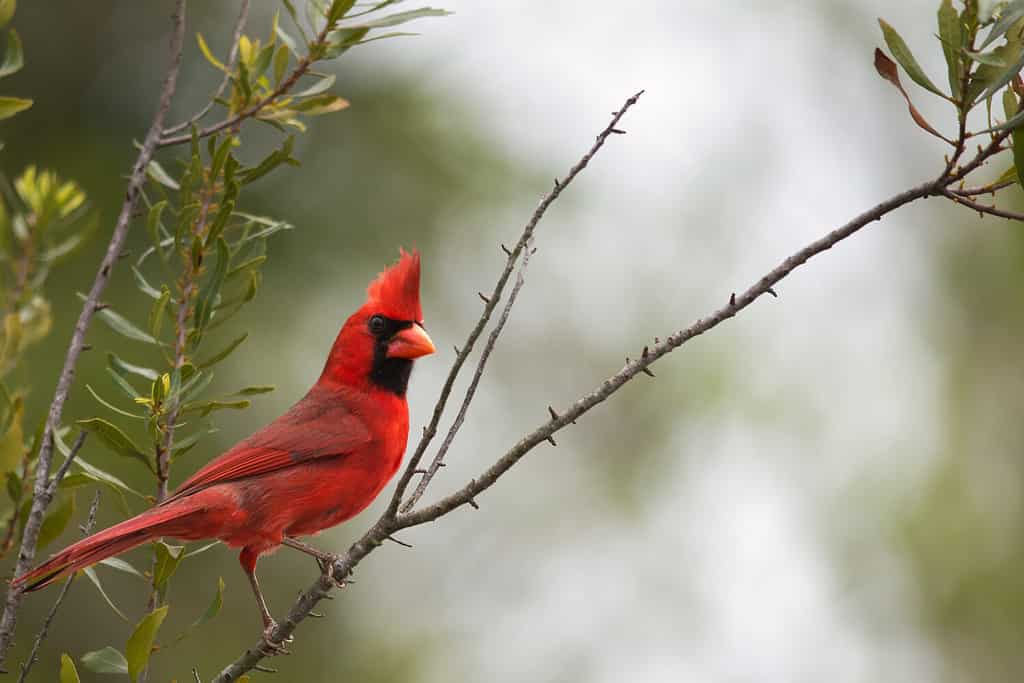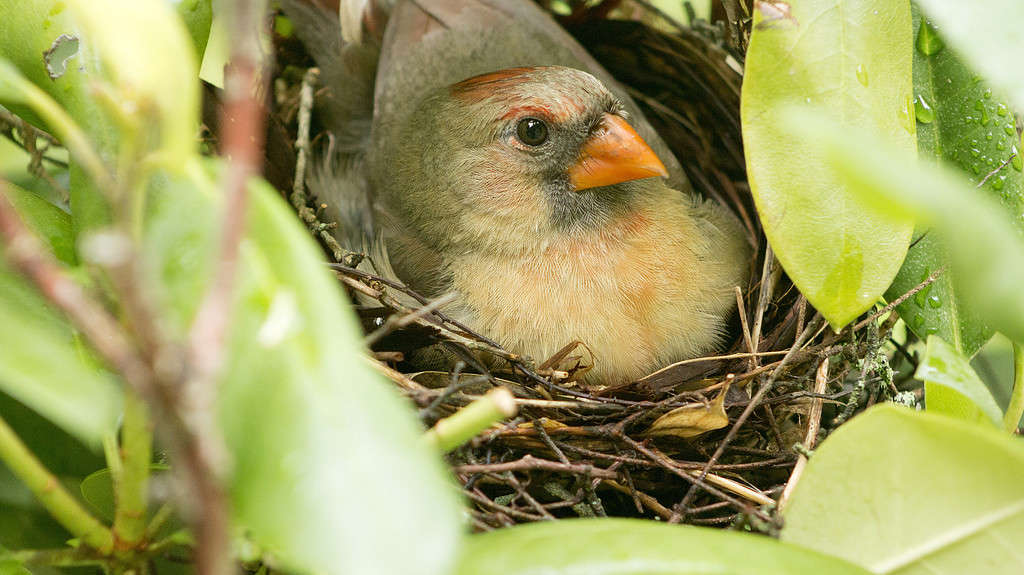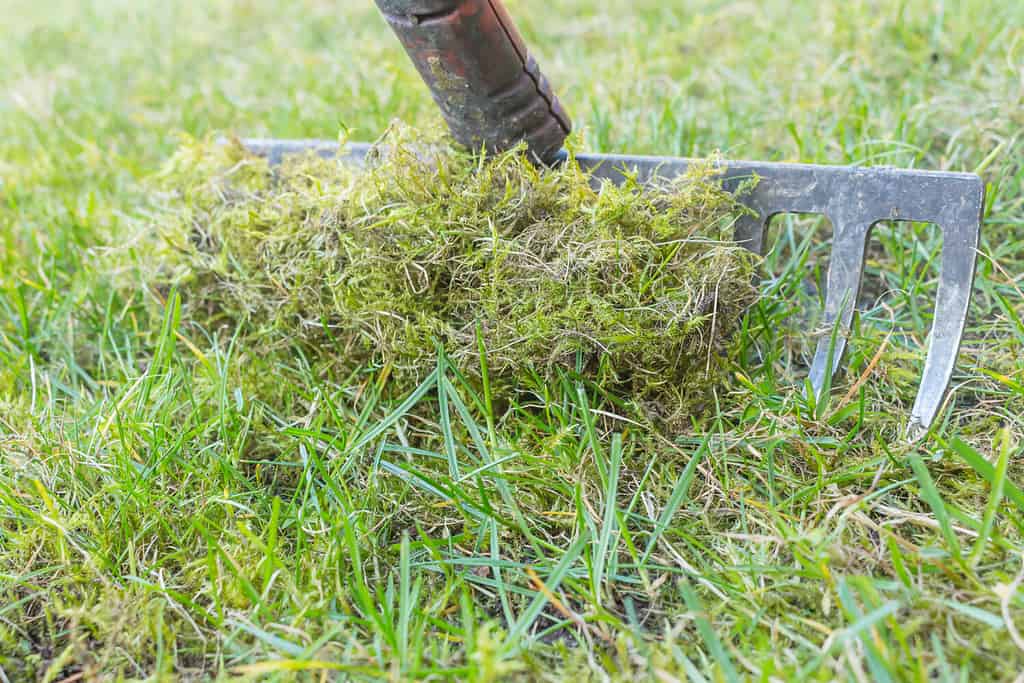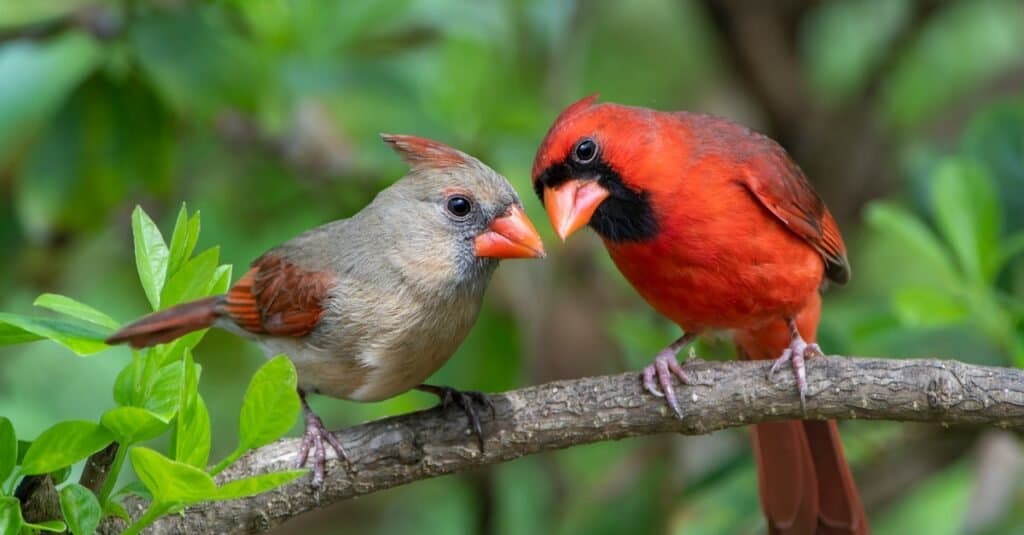With brilliant red plumage, cardinals are some of the easiest and most fun birds to spot in the wild. They frequent many parts of North America as well as other continents. Because these birds are not migratory, you’ll have a chance to see cardinals all year long in many cases. They can be particularly striking in the winter when their bright red feathers really pop against a white snowy landscape.
Female cardinals have more subdued coloring, however. Like many animals, the females blend in better with their environment. This helps protect both the mothers and the nests as they care for their eggs and chicks.
When Do Cardinals Build Their Nests?

Cardinals usually begin building their nests in late winter or early spring, with the males taking on the role of material gatherer.
©David Spates/Shutterstock.com
These birds start building their nests around February at the earliest. Some parents get a later start but most are busy with construction by the early spring. The females build the nests between 3 and 10 feet off the ground, depending on what kind of structures they can find. Large shrubs, bushes, and trees are all popular choices among cardinals. They construct their nests out of twigs, grass, roots, vines, and pieces of bark. This makes the basic structure. The mothers-to-be line the inside with softer weeds and grass to create a nice, warm place for their eggs to incubate.
Typically, it takes up to 9 days for a cardinal to build one nest. Some work a bit faster and can be done in as few as 3 days. These nests can be used for a single clutch, or group of eggs, or multiple times within one year. They are known as cup nests and resemble a bowl. The female lays a small group of eggs inside, where they will eventually hatch. The nests are around 3 or 4 inches in diameter and around 3 inches tall. The female uses her beak to bend the materials into a rough shape that she wants before adding them to the nest. Then, she stomps around inside to perfect the shape.
Cardinals are busiest building their nests in the early morning. It could be that the temperatures are ideal during this time of day or they just want to get an early start on the day’s work. They are also early eaters, frequently the first spotted at the birdfeeder if you have one set up. These birds embody the motto “the early bird gets the worm.” In this case, the early cardinal gets the birdseed and a prime spot to build a nest.
Where Can I See a Cardinal Nest?

Female Northern Cardinals incubate the eggs alone.
©WoodysPhotos/iStock via Getty Images
These birds tend to build their nests at least a few feet up to keep them far away from potential predators. Snakes, squirrels, and chipmunks all go after cardinal eggs that they can find in an unattended nest. Even some other birds, such as bluejays, will try to make a tasty meal out of a cardinal egg. This is one reason why females will sit on the eggs more often than males. Their brown feathers help them camouflage the eggs. Males have bright red feathers, which can be easily seen by predators.
Both male and female cardinals tend the nest, however. The female takes on the bulk of the work to actually build the nest. The male’s job is to scout out and bring back good nest-building supplies. If you see a bright red cardinal frequently returning to the same location high up in a tree, there’s a good chance that he is helping to build a nest, watch for threats, or take care of baby chicks. The male cardinal’s coloring makes him easier for predators to spot, which isn’t great. This is why the female is responsible for incubating the eggs since she provides some camouflage. But the male’s bright coloring makes it easier for avid birdwatchers to catch a glimpse of his growing family.
If you want to get a good look, check out the places in trees or shrubs where sturdy branches come together. These are the best supports for the nest and reduce the chances that it will fall to the ground. Cardinals tend to build their nests in dense spots that can be protected from the elements and potential predators.
Nest Materials for Cardinals

Grass and moss make great nest-building materials for cardinals and other birds.
©philmillster/Shutterstock.com
Like many birds, cardinals use things that they can find in their environment to build their nests. Small twigs and grasses are some of the most common because they are usually plentiful and the cardinal can weave them together to create a sturdy structure. Pieces of bark tend to be a bit firmer but also make great nest-building materials. They are made in cup shapes that can support the clutch of eggs and later baby chicks in the nest.
The inside is lined with softer materials than the outside to provide a cozy environment. Grass and leaves make great interior materials. Pine needles can also be used. For those cardinals lucky enough to find bits of fur, hair, or fibers, the inside of the nest is really comfy. If you want to help cardinals during nesting season, try to stick with materials that they might find in nature. You can create a place to drop off small twigs that you find, making collection easier for the birds. Moss, leaves, and feathers are also great materials for the inside of the nest. Even though you might be tempted to provide some manmade cozy materials like fabric, dryer lint, or other fibers, these aren’t made to be used outdoors and can actually cause more harm than good. Plus, it interferes with the cardinal’s natural nest-building abilities.
Do Cardinals Return to the Same Nests?
Cardinals almost always build new nests each year. While they are excellent builders, their nests just aren’t made to hold up to the elements for such a long time. They’ll need to gather new materials and make a new home for their family each year. Depending on the conditions and circumstances, they might even need to build new nests within a single year. They won’t move a clutch of eggs from nest to nest. But they might upgrade to a new nest before laying their second or third clutch of the year. Cardinals do not migrate and may come back to the same area to build a new nest each year.
While you may not be able to revisit a cardinal’s nest each year, you can still attract these amazing birds to your yard. Cardinals build nests in trees, not birdhouses, so don’t expect much if you put out a birdhouse. However, they love bird feeders and will frequently return to nibble on some birdseed or other snacks that you put out. These can be elaborate posts or stands with structures on top or as simple as a pinecone coated with peanut butter and seeds, then hung from a branch. Either way, the cardinals will love to check it out. If you have good spots for them to build their nests in trees, bushes, or shrubs nearby, they might just set up camp and not see much of a reason to leave.
How Many Eggs Are in Their Nests?

Both female and male cardinals are involved in nest building and caring for chicks.
©Bonnie Taylor Barry/Shutterstock.com
Cardinals tend to build their nests early so they can have multiple broods each year. Typically, the female lays the first brood in March, just after the nest is complete. They incubate for between 11 and 13 days before they hatch. Then, the babies are tended to by both parents for up to 2 weeks before they are thrust from the nest and forced to fly on their own. These fledgling birds need food and protection from their parents in the beginning. But generally, by two weeks, they are ready to soar on their own (give or take a few practice flights). This process is repeated with a second brood, often in May or June. Some cardinals even find time for a third brood, although most are done laying eggs by August.
Most clutches of eggs are between 2 and 5 at a time. It’s rare for a cardinal to lay just one egg in a clutch. If you do come across a nest with only a single egg, this might be thanks to predators making off with the others before they were able to hatch.
Cardinal Eggs and Baby Birds
Their eggs are usually off-white with a green or buff tint to them. They are speckled with either brown or gray coloring. Cardinal eggs are around 1 inch long. If you find a nest with eggs, no matter the species, you should leave them be. The parents might be nearby and monitoring the nest, waiting for you to leave. Cardinals typically don’t attack potential predators but they can make loud noises to try to scare them off. The females rely on their camouflage to keep the eggs safe.
If you find a solitary egg on the ground, you should also leave it alone. It is highly unlikely that the egg will hatch and the chances of reintroducing it to nest are very slim. If you try, you’re more likely to put the other eggs or chicks in danger. The fallen egg might make a good snack for other wildlife who rely on things like bird eggs for their own survival. While we may not like to see an egg meet a tragic end, it is part of the natural circle of life.
Do Cardinals Mate for Life?
In addition to being fun to watch, cardinals are also quite romantic. They almost always mate in long-term relationships, raising multiple broods each year together. Even though the female is in charge of incubating the eggs, relying on her brown feathers to keep them camouflaged, the male is a very attentive parent as well. He brings materials to help build the nest, brings food for the female while she sits on the nest, and watches out for predators. After the chicks hatch, both parents take turns to find food and feed them.
They tend to stay in the same pair all through the breeding season, which can last for most of the year. Male cardinals woo the females by feeding them tasty seeds. Sometimes, mated pairs stick together for life. Other times, they go their separate ways after the breeding season is over. Either way, cardinals make excellent parents who take turns caring for their young together.
The photo featured at the top of this post is © Tara Melinda/Shutterstock.com
Thank you for reading! Have some feedback for us? Contact the AZ Animals editorial team.







